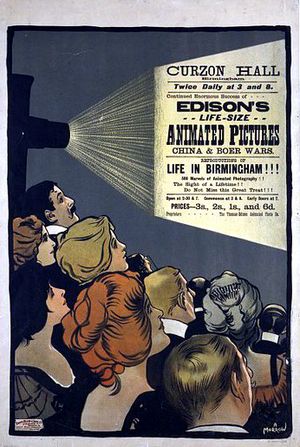Albert Morrow facts for kids
Quick facts for kids
Albert Morrow
|
|
|---|---|
| Born | 26 April 1863 |
| Died | 26 October 1927 (aged 64) West Hoathly, West Sussex, England
|
| Nationality | Irish |
| Alma mater | Government School of Art, Belfast |
| Known for | Illustration, poster design, cartooning |
Albert George Morrow (born April 26, 1863 – died October 26, 1927) was a talented Irish artist. He was famous for his amazing illustrations, eye-catching posters, and funny cartoons. His work helped shape how people saw advertisements and stories in his time.
Contents
Early Life and Family
Albert Morrow was born in a place called Comber, in County Down, Ireland. He was the second son in his family. His father, George Morrow, was a painter and decorator.
Albert came from a very artistic family! Out of his seven brothers, four of them – George, Jack, Edwin, and Norman – were also illustrators. Almost all his brothers became artists. When he was young, Albert loved studying birds. Later in life, he enjoyed walking and painting beautiful landscapes just for fun.
Learning to Be an Artist
Albert Morrow went to the Belfast Model School. After that, he studied art at the Government School of Art in Belfast from 1878 to 1881.
Early Art Achievements
In 1880, while still learning, Albert won a £10 prize for his drawing skills. This award came from a famous publisher called Cassell, Petter and Galpin. The next year, in 1881, he painted a large picture of Belfast for the Working Men's Institute. His father was actually in charge there! Later that same year, he showed a watercolor painting called Meditative in a Belfast art gallery.
Studying in London
Albert then won a special scholarship that paid him £52 each year for three years. He used this to study at the National Art Training School in London, starting in 1882. There, he became lifelong friends with a British sculptor named Albert Toft.
In 1883, while still a student, Albert Morrow started working for the English Illustrated Magazine. He helped get it ready for its very first issue. Some of his drawings were also printed in the Sunday at Home magazine that same year. People noticed his talent early on.
Praised by Writers
Comyns Carr, the first editor of the English Illustrated Magazine, asked Albert to create a series of drawings about English industries. Albert hadn't even finished his studies yet! In 1885, a writer from the Belfast Newsletter newspaper said that Albert's illustrations were among the best. They called him "one of the most careful and observant artists of the day."
His Artistic Career
In 1890, Albert Morrow began creating illustrations for magazines like Bits and Good Words. He showed nine of his watercolor paintings at the Royal Academy of Arts between 1890 and 1904. He also exhibited one more in 1917 and another in chalk in 1927, the year he passed away.
Joining Art Societies
Albert became a member of the Belfast Art Society in 1895 and showed his work with them that same year. In 1896, one of his prints was chosen for a special collection called Les Maîtres de l'Affiche, which featured the best poster artists. That year, he also displayed a watercolor of a Gurkha soldier at an exhibition in London.
In 1900, Albert Morrow had an exhibition with two other artists from Ulster, Hugh Thomson and Arthur D McCormick. These artists, including Albert, had all helped the English Illustrated Magazine become successful.
Founding the Ulster Arts Club
In November 1902, Albert Morrow and five of his brothers helped start the Ulster Arts Club. This club was interested in Irish culture, language, and art. In November 1903, he showed his work at the club's first yearly exhibition. He displayed his painting The Itinerant Musician, which he had shown before at the Royal Academy. The club made him an honorary member the next year. Three years later, he had his own exhibition of sketches and posters with the Ulster Arts Club in Belfast.
Family Exhibitions and Petitions
In 1908, Albert joined his brothers in an exhibition in Dublin. Among his contributions was a painting of Brandon Thomas called The Clarionette Player and a poster titled Irving in Dante.
In 1917, Albert and his brother George joined 150 other artists and writers. They asked the British Prime Minister, Lloyd George, to help create a gallery in Dublin for Hugh Lane's art collection. Many famous artists, like Jack B Yeats and Sir William Orpen, also signed this request.
Famous for Posters
Albert Morrow illustrated books for both children and adults. However, he is most famous for the hundreds of posters he designed for the theatre. Most of these posters were made for one printing company, David Allen and Sons. He also drew cartoons for children's yearly books and contributed three cartoons to Punch magazine in 1923, 1925, and one after he died in 1931.
Later Life and Legacy
Albert George Morrow passed away at his home in West Hoathly, West Sussex, on October 26, 1927. He was 64 years old. He left behind his wife and two children. His good friend, the sculptor Albert Toft, designed the headstone for his grave.
You can find Albert Morrow's amazing artworks in many public and private collections today. Some of these include the Victoria and Albert Museum in London, the Musée des Arts Décoratifs in Paris, and the British Museum.


